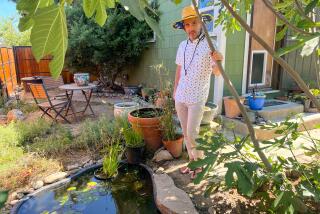Pathway to a Garden of Visual Delights
- Share via
One of the most enjoyable aspects of visiting a public garden or park is the sense of discovery when heading out on a path. Why not give that same sense of adventure to your backyard?
“Garden paths are more than functional,” says Ted Mayeda, owner of M&M; Nursery in Orange. “They give the garden intrigue. Visitors can’t wait to find out what’s at the end of the path.”
Well-placed paths connect the yard to the house visually and physically, creating a series of outdoor rooms. By providing transitions from one part of the yard to another, paths give a garden a sense of definition and purpose.
Perhaps best of all, paths can make a small garden seem much larger, says Karen Veeh, co-owner of Keck & Barrett in Glendale. She and her partner, Joy Densmore, create handcrafted mosaic decorative items for the home and garden, including steppingstones.
“With the use of paths, I’ve seen small, rectangular plots, which are common in Southern California, turned into amazing spaces that bear exploring,” Veeh says. “It’s possible to pack in a lot of plants along a path, without making the space feel crowded.”
A meandering path through a small plot can send you on a journey that makes the area seem much larger. This effect is created by edging the path with tall plants that prevent you from seeing other parts of the yard.
Paths can also be used to provide direction and invite you to see what is beyond.
“You can arrange a path so that it leads to something wonderful, like a really great view, a place to sit and reflect or a water feature,” Veeh says. “The sound of running water is always alluring.”
Here are some things to consider:
Determine what type of path you want and where you want to lead people.
Practical paths for well-traveled routes--such as to the shed, compost heap, vegetable garden and grill--should be direct. To plan the best route, look for signs of wear in the yard, or monitor your movements for a few days to see where you travel most.
Customize Your Plan
Strolling paths allow for more creativity. Such trails can wind along, passing by eye-catching plants and eventually reaching a memorable destination, such as a statue, fountain, bench, small table and chairs, hot tub, a hammock in a shady spot or a breathtaking view.
A fork in the path at some point can be intriguing, allowing you to stop and make a decision. At such an intersection, you could combine function and fun by having one pathway lead to something practical, such as a shed or potting bench, and the other end at a secret garden spot.
The width of your path will depend on how much space you have. In general, 3 feet is adequate for most paths, although you may want it wider if a wheelbarrow, lawn mower or wheelchair will be passing through.
Pathway materials are numerous and diverse. They include steppingstones, bark chips, gravel and lava rock.
When choosing materials, consider that the path should complement the style of your yard and house, Mayeda says.
“Something like shells would look good at the beach, and lava rock or gravel would blend well in a succulent type garden,” he says. “Bark chips give a more informal appearance, while certain styles of steppingstones can lend a formal look.”
Decorative steppingstones come in many styles and allow you to carry a theme throughout the garden, says Veeh, whose company produces a variety of steppingstones, including some with bumblebees, butterflies, rabbits and ladybugs.
Don’t overuse decorative steppingstones, however. “It’s often too overwhelming on the eye to use all decorative steppingstones,” Veeh says. “We suggest interspersing them with plain pavers.”
Opt for Durability
If you get steppingstones, choose those that are durable and have an even, nonslip surface, Veeh says.
“Stones made of concrete are best, because they are sturdy enough to withstand weight without cracking or breaking and are made to weather well,” she says.
“Although resin steppingstones are popular and readily available, they tend to break. It’s also important that decorative stones have grout or concrete poured around design elements such as shells or stones so that the items don’t fall out.”
When placing steppingstones, space them to accommodate a natural stride. Also prevent tripping by placing the stones flush with ground level.
A Fragrant Journey
Generally, it looks best to plant low-growing ground cover near the path and around steppingstones, small plants right next to the path and then move up in height from there, placing the tallest plants farthest away from the path.
How tall the plants get will depend on whether you are trying to shield certain parts of the yard and how much of an enclosed look you’re striving for. At pauses or curves in the path, put surprises that make the walker stop and look down, such as unusual plants or small garden statues.
Create a fragrant journey by placing plants with scented foliage at the edge of your pathway. Plants such as lavender, rosemary and scented geraniums will release a pleasant odor
More to Read
Sign up for The Wild
We’ll help you find the best places to hike, bike and run, as well as the perfect silent spots for meditation and yoga.
You may occasionally receive promotional content from the Los Angeles Times.






